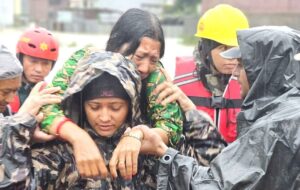Physical Address
23,24,25 & 26, 2nd Floor, Software Technology Park India, Opp: Garware Stadium,MIDC, Chikalthana, Aurangabad, Maharashtra – 431001 India
Physical Address
23,24,25 & 26, 2nd Floor, Software Technology Park India, Opp: Garware Stadium,MIDC, Chikalthana, Aurangabad, Maharashtra – 431001 India

From September 26-28, 2024, Nepal was hit by extreme rainfall, leading to devastating flash floods and landslides, particularly affecting the capital, Kathmandu, and nearby regions. The floods, driven by overflowing rivers including the Bagmati, Sapakoshi, and Narayani, claimed 244 lives and severely disrupted transportation, with 19 major roads damaged and landslides blocking key highways.
A joint study by researchers from Nepal, India, Sweden, Australia, the US, and the UK, of the World Weather Attribution (WWA) group explored the impact of human-induced climate change on the intensity and likelihood of this heavy rainfall. A rapid attribution found that due to human-induced climate change, extreme rainfall events like the one in Nepal are about 70% more likely in today’s climate, which is 1.3°C warmer than pre-industrial times. Additionally, climate change has made the rainfall 10% heavier.
Their analysis also showed that Kathmandu and Lalitpur’s rapid urbanisation—386% growth in built-up areas between 1990 and 2020—and deforestation have severely compromised natural water drainage, increasing surface runoff and exacerbating flood risks.
Researchers found that heavy 3-day rainfall events have become 18% more intense and twice as likely due to climate change. The increasing warmth of the atmosphere, capable of holding more moisture, has been a significant factor in this intensification. The rainfall recorded during this event was the highest in 54 years, classified as a 1-in-50-year occurrence.
“Yet again, we’ve seen fatalities from a flood in Asia reach triple digits in 2024. The world’s sluggish shift away from oil, gas and coal is resulting in death for the poorest, most vulnerable people. Floods like these will keep getting bigger, deadlier and costlier until fossil fuels are replaced with renewable energy,” said Friederike Otto, one of the scientists behind the study by World Weather Attribution (WWA).
The study found that while flood warnings were issued, they failed to adequately address the impacts on Kathmandu. The lack of targeted flood risk management for the valley, coupled with the vulnerability exacerbated by the 2015 Gorkha earthquake and rapid urban expansion into floodplains, has heightened the region’s exposure, the study pointed out.
The study emphasizes the need for better disaster risk reduction policies, comprehensive spatial planning, and anticipatory action systems to protect urban centers like Kathmandu from future flooding risks.
Also Read: Record Rainfall Kills 170 in Nepal: Haphazard Development Increases Climate Risks, Experts Warn
References:
Climate Change and Rapid Urbanization Key Drivers of Deadly Nepal Floods, Analysis Shows
Banner Image: https://www.worldweatherattribution.org/rapid-urbanisation-and-climate-change-key-drivers-of-dramatic-flood-impacts-in-nepal/